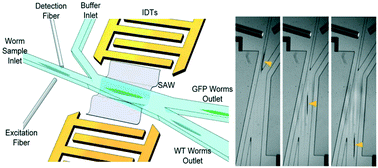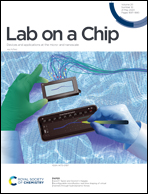Fluorescence-based sorting of Caenorhabditis elegans via acoustofluidics†
Abstract
Effectively isolating and categorizing large quantities of Caenorhabditis elegans (C. elegans) based on different phenotypes is important for most worm research, especially genetics. Here we present an integrated acoustofluidic chip capable of identifying worms of interest based on expression of a fluorescent protein in a continuous flow and then separate them accordingly in a high-throughput manner. Utilizing planar fiber optics as the detection unit, our acoustofluidic device requires no temporary immobilization of worms for interrogation/detection, thereby improving the throughput. Implementing surface acoustic waves (SAW) as the sorting unit, our device provides a contact-free method to move worms of interest to the desired outlet, thus ensuring the biocompatibility for our chip. Our device can sort worms of different developmental stages (L3 and L4 stage worms) at high throughput and accuracy. For example, L3 worms can be processed at a throughput of around 70 worms per min with a sample purity over 99%, which remains over 90% when the throughput is increased to around 115 worms per min. In our acoustofluidic chip, the time period to complete the detection and sorting of one worm is only 50 ms, which outperforms nearly all existing microfluidics-based worm sorting devices and may be further reduced to achieve higher throughput.



 Please wait while we load your content...
Please wait while we load your content...